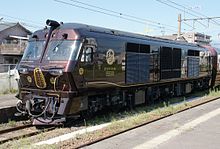JR Freight Class DF200
| Class DF200 | |||||||||||||||||||||||||||
|---|---|---|---|---|---|---|---|---|---|---|---|---|---|---|---|---|---|---|---|---|---|---|---|---|---|---|---|
 DF200-901 and DF200-6 in January 2008 | |||||||||||||||||||||||||||
| |||||||||||||||||||||||||||
| |||||||||||||||||||||||||||
| |||||||||||||||||||||||||||
| |||||||||||||||||||||||||||
The Class DF200 (DF200形) is a Bo-Bo-Bo wheel arrangement diesel–electric locomotive type operated by the Japan Freight Railway Company (JR Freight)[1] and the Kyushu Railway Company.
As of 1 March 2017[update], JR Freight operates 48 Class DF200s, and JR Kyushu operates one (DF200-7000).[2]
Background
[edit]In Hokkaido, where the proportion of electrified sections on trunk lines is low, the Class DD51 had been the mainstay of freight transport since the introduction of "smokeless railways", regardless of whether they ran on electrified or non-electrified sections. After the creation of JR, the increase in freight transportation and the increasing speed of freight trains made the DD51's traction capacity insufficient, requiring trains to run with double heading. Due to the harsh climate in Hokkaido, the cars also became increasingly obsolete. To address these issues, the DF200 was developed.[3][4][5]
It was rewarded with Laurel_Prize in 1994.
Variants
[edit]- DF200-900
- DF200-0
- DF200-50
- DF200-100
- DF200-200
- DF200-7000 (JR Kyushu)
DF200-900
[edit]The pre-production locomotive DF200-901 was delivered in March 1992 for testing. It has two MTU 12V396TE14 diesel engines.[1]
-
DF200-901 in December 2012
DF200-0
[edit]Full-production batch delivered from 1994. Red "JRF" logos were later replaced by white logos. 12 locomotives were built.[1]
-
DF200-3 in October 2012
DF200-50
[edit]Batch built from March 2000 with Komatsu SDA12V170-1 diesel engines in place of the earlier MTU engines. External changes include grey front-end skirts, white "JRF" logos, and "Red Bear Eco Power" logos. 13 locomotives were built.[1]
-
DF200-52 in October 2009
DF200-100
[edit]Batch built from August 2005 to December 2011 with IGBT VVVF inverters.[1] 23 Class DF200-100 locomotives were built.[6]
-
DF200-105 in October 2011
DF200-200
[edit]In 2016, DF200-123 was moved from Hokkaido to Suita Depot in Osaka,[7] where it underwent modifications and renumbering to DF200-223 before being returned to service on the Kansai Main Line in the Nagoya area.[2][8] This was followed by locomotives DF200-116 and DF200-120, which were similarly modified and renumbered DF200-216 and DF200-220 respectively in 2018.[9]
DF200-7000
[edit]
A dedicated Class DF200-7000 diesel locomotive was built in 2013 for JR Kyushu's Seven Stars in Kyushu luxury excursion train. Built specially for use in Kyushu and finished in a deep maroon livery, the locomotive was built by Kawasaki Heavy Industries in Kobe, and delivered in July 2013.[10][11]
Classification
[edit]The DF200 classification for this locomotive type is explained below.
- D: Diesel locomotive
- F: Six driving axles
- 200: Diesel–electric locomotive with AC motors
References
[edit]- ^ a b c d e JR全車輌ハンドブック2006 [JR Rolling Stock Handbook 2006]. Japan: Neko Publishing. 2006. ISBN 978-4-7770-0453-9.
- ^ a b Kisumi, Kenzo (April 2017). 世代交代が進むJR貨物の機関車 [Advances in handover between generations for JR Freight locomotives]. Tetsudo Club (in Japanese). Vol. 2. Japan: Cosmic Publishing. pp. 98–100. ISBN 978-4-7747-8338-3.
- ^ 日本貨物鉄道株式会社 技術開発部・北海道支社運輸車両課 「JR貨物 DF200形式電気式ディーゼル機関車 開発から誕生の経過」『鉄道ピクトリアル』1996年5月号(No.621)pp.16-24
- ^ 「蘇った"電気式" ディーゼル機関車 DF200」『鉄道ダイヤ情報』2005年8月号(No.256) pp.4-7
- ^ 「威風堂々"走る発電所" DF200型のメカニズムに迫る」『鉄道ダイヤ情報』2005年8月号(No.256) pp.20-23
- ^ JR車両ファイル2012 [JR Rolling Stock File 2012]. Japan Railfan Magazine. Vol. 52, no. 615. Japan: Kōyūsha Co., Ltd. July 2012. p. 64.
- ^ DF200-123が吹田機関区へ [DF200-123 moved to Suita Depot]. Japan Railfan Magazine Online (in Japanese). Japan: Koyusha Co., Ltd. 22 January 2016. Retrieved 27 May 2016.
- ^ JR車両ファイル2016 [JR Rolling Stock File 2016]. Japan Railfan Magazine (in Japanese). Vol. 56, no. 663. Japan: Koyusha Co., Ltd. July 2016. p. 56.
- ^ DF200-220が出 [DF200-220 outshopped]. Japan Railfan Magazine Online (in Japanese). Japan: Koyusha Co., Ltd. 7 February 2018. Archived from the original on 9 February 2018. Retrieved 9 February 2018.
- ^ JR九州「ななつ星in九州」の概要を発表 [JR Kyushu announces details of "Seven Stars in Kyushu"]. Railway Journal (550): 146. August 2012.
- ^ ななつ星の機関車完成、いざ九州へ [Seven Stars locomotive completed and delivered to Kyushu]. Yomiuri Online (in Japanese). Japan: The Yomiuri Shimbun. 2 July 2013. Archived from the original on 2013-07-07. Retrieved 2 July 2013.
External links
[edit]- JR Freight website (in Japanese)
- Details on Kawasaki Heavy Industries website (in Japanese)





